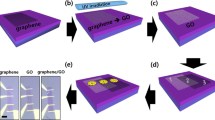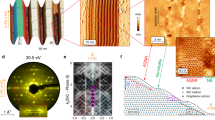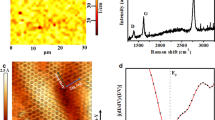Abstract
Graphene has shown great application potential as the host material for next-generation electronic devices. However, despite its intriguing properties, one of the biggest hurdles for graphene to be useful as an electronic material is the lack of an energy gap in its electronic spectra. This, for example, prevents the use of graphene in making transistors. Although several proposals have been made to open a gap in graphene’s electronic spectra, they all require complex engineering of the graphene layer. Here, we show that when graphene is epitaxially grown on SiC substrate, a gap of ≈0.26 eV is produced. This gap decreases as the sample thickness increases and eventually approaches zero when the number of layers exceeds four. We propose that the origin of this gap is the breaking of sublattice symmetry owing to the graphene–substrate interaction. We believe that our results highlight a promising direction for bandgap engineering of graphene.
This is a preview of subscription content, access via your institution
Access options
Subscribe to this journal
Receive 12 print issues and online access
$259.00 per year
only $21.58 per issue
Buy this article
- Purchase on Springer Link
- Instant access to full article PDF
Prices may be subject to local taxes which are calculated during checkout




Similar content being viewed by others
References
Novoselov, K. S. et al. Electric field effect in atomically thin carbon films. Science 206, 666–669 (2004).
Novoselov, K. S. et al. Two-dimensional gas of Dirac fermions in graphene. Nature 438, 197–200 (2005).
Zhang, Y. B., Tan, Y.-W., Stormer, H. L. & Kim, P. Experimental observation of the quantum Hall effect and Berry’s phase in graphene. Nature 438, 201–204 (2005).
Berger, C. et al. Electronic confinement and coherence in patterned epitaxial graphene. Science 312, 1191–1196 (2006).
Manes, J. L., Guinea, F. & Vozmediano, A. H. Existence and topological stability of Fermi points in multilayered graphene. Phys. Rev. B 75, 155424 (2007).
Trauzettel, B., Bulaev, D. V., Loss, D. & Burkard, G. Spin qubits in graphene quantum dots. Nature Phys. 3, 192–196 (2007).
Nakada, K., Fujita, M., Dresselhaus, G. & Dresselhaus, M. S. Edge state in graphene ribbons: Nanometer size effect and edge shape dependence. Phys. Rev. B 54, 17954–17961 (1996).
Brey, L. & Fertig, H. A. Electronic states of graphene nanoribbons studied with the Dirac equation. Phys. Rev. B 73, 235411 (2006).
Nilsson, J., Castro Neto, A. H., Guinea, F. & Peres, N. M. R. Transmission through a biased graphene bilayer barrier. Preprint at <http://www.arxiv.org/abs/cond-mat/0607343> (2006).
Rollings, E. et al. Synthesis and characterization of atomically-thin graphite films on a silicon carbide substrate. J. Phys. Chem. Solids 67, 2172–2177 (2006).
Calandra, M. & Mauri, F. Electron-phonon coupling and electron self-energy in electron-doped graphene: calculation of angular resolved photoemission data. Preprint at <http://www.arxiv.org/cond-mat/abs/0707.1467> (2007).
Bostwick, A., Ohta, T., Seyller, T., Horn, K. & Rotenberg, E. Quasiparticle dynamics in graphene. Nature Phys. 3, 36–40 (2006).
Zhou, S. Y. et al. First direct observation of Dirac fermions in graphite. Nature Phys. 2, 595–599 (2006).
Zhou, S. Y., Gweon, G.-H. & Lanzara, A. Low energy excitations in graphite: The role of dimensionality and lattice defects. Ann. Phys. 321, 1730–1746 (2006).
Berger, C. et al. Ultrathin epitaxial graphite: 2D electron gas properties and a route toward graphene-based nanoelectronics. J. Phys. Chem. B 108, 19912–19916 (2004).
McClure, J. M. Band structure of graphite and de Haas-van Alphen effect. Phys. Rev. 108, 612–618 (1957).
Dresselhaus, M. S. & Dresselhaus, G. Intercalation compounds of graphite. Adv. Phys. 51, 1–186 (2002).
Guinea, F. Charge distribution and screening in layered graphene systems. Phys. Rev. B 75, 235433 (2007).
Castro, E. V. et al. Biased bilayer graphene: Semiconductor with a gap tunable by electric field effect. Preprint at <http://www.arxiv.org/abs/cond-mat/0611342> (2006).
McCann, E. & Fal’ko, V. I. Landau-level degeneracy and quantum Hall effect in a graphite bilayer. Phys. Rev. Lett. 96, 086805 (2006).
Ohta, T., Bostwick, A., Seyller, T., Horn, K. & Rotenberg, E. Controlling the electronic structure of bilayer graphene. Science 313, 951–954 (2006).
Tsai, M.-H., Change, C. S., Dow, J. D. & Tsong, I. S. T. Electronic contributions to scanning-tunneling-microscopy images of an annealed β-SiC(111) surface. Phys. Rev. B 45, 1327–1332 (1992).
Mallet, P. et al. Electron states of mono- and bilayer graphene on SiC probed by STM. Preprint at <http://www.arxiv.org/abs/cond-mat/0702406> (2007).
Rutter, G. M. et al. Scattering and interference in epitaxial graphene. Science 317, 219–222 (2007).
Brar, V. et al. Scanning tunneling spectroscopy of inhomogeneous electronic structure in monolayer and bilayer graphene on SiC. Preprint at <http://www.arxiv.org/cond-mat/abs/0706.3764> (2007).
Rutter, G. et al. APS March meeting, W29.00013 (2007).
Hembacher, S., Giessibl, F. J., Mannhart, J. & Quate, C. F. Revealing the hidden atom in graphite by low-temperature atomic force microscopy. Proc. Natl Acad. Sci. USA 100, 12539–12542 (2003).
Varchon, F. et al. Electronic structure of epitaxial graphene layers on SiC: Effect of the substrate. Preprint at <http://www.arxiv.org/abs/cond-mat/0702311> (2007).
Emtsev, K. V. et al. Initial stages of the graphite–SiC(0001) interface formation studied by photoelectron spectroscopy. Mater. Sci. Forum 556–557, 525 (2007).
Shirley, E. L., Terminello, L. J., Santoni, A. & Himpsel, F. J. Brillouin-zone-selection effects in graphite photoelectron angular distributions. Phys. Rev. B 51, 13614–13622 (1995).
Acknowledgements
We thank A. Geim and A. H. MacDonald for useful discussions and J. Graf for experimental assistance. This work was supported by the National Science Foundation through Grant No. DMR03-49361, the Director, Office of Science, Office of Basic Energy Sciences, Division of Materials Sciences and Engineering of the US Department of Energy under Contract No. DEAC03-76SF00098 and by the Laboratory Directed Research and Development Program of Lawrence Berkeley National Laboratory under the Department of Energy Contract No. DE-AC02-05CH11231. A.H.C.N. was supported through NSF grant DMR-0343790. S.Y.Z. thanks the Advanced Light Source Fellowship for financial support.
Author information
Authors and Affiliations
Corresponding author
Ethics declarations
Competing interests
The authors declare no competing financial interests.
Supplementary information
Supplementary Information
Supplementary information and figures S1-S3 (PDF 514 kb)
Rights and permissions
About this article
Cite this article
Zhou, S., Gweon, GH., Fedorov, A. et al. Substrate-induced bandgap opening in epitaxial graphene. Nature Mater 6, 770–775 (2007). https://doi.org/10.1038/nmat2003
Received:
Accepted:
Published:
Issue Date:
DOI: https://doi.org/10.1038/nmat2003
This article is cited by
-
Spatial quasi-bound states of Dirac electrons in graphene monolayer
Scientific Reports (2024)
-
Tailoring graphene for electronics beyond silicon
Nature (2024)
-
Towards growth of pure AB-stacked bilayer graphene single crystals
Nano Research (2024)
-
The reformation of catalyst: From a trial-and-error synthesis to rational design
Nano Research (2024)
-
New methods to increase PVR in gate controllable armchair graphene-boron nitride RTDs
Optical and Quantum Electronics (2024)



